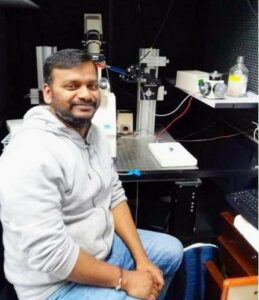Saravanan Arumugam, PhD, was awarded $100,000 for his research project, “Role of Cytosolic and Mitochondrial Ca2+ in the Pathogenesis of Spinal Muscular Atrophy.”
Dr. Arumugam’s basic research grant is one of five awarded by Cure SMA in 2022 totaling $500,000.
Meet Dr. Arumugam

Tell us about yourself.
I am a postdoctoral fellow in the Department of Medical Physiology and Biophysics at the University of Seville, Spain. I received my PhD from the University of Lleida (Spain), where I acquired the skill of culturing embryonic motor neurons and obtained expertise in genetically modified mice and molecular biology. I studied the signaling pathways involved in the pathogenesis of SMA.
As a part of my PhD, at the University of Seville, I gained expertise using the patch-clamp technique to record ionic currents from cultured motor neurons. During my postdoctoral training at Northwestern University, Lurie Children’s Hospital of Chicago, I performed live imaging of mitochondria in motor neuron cultures.
How did you first become involved with SMA research?
My first involvement in SMA research started in 2012 when I began my PhD. We established the role of the NF-κB signaling pathway in SMA disease. Later, I investigated the part the SMN protein plays in regulating the electrical excitability of cultured embryonic motor neurons.
What is your current role in SMA research?
Currently, we are using electrophysiological and imaging techniques to study calcium homeostasis in motor neurons and nerve terminals that are affected by SMA.
What are the project goals?
The concentration of calcium inside cells affects many processes. Calcium is especially important in motor neurons, where it plays a major role in communication with muscles. Without active communication between motor neurons and muscle cells, muscles will atrophy and weaken.
SMA is caused by a deficiency in the survival motor neuron (SMN) protein that results from mutations in the survival motor neuron gene, SMN1. The regulation of calcium, called “calcium homeostasis,” is altered in SMN-deficient motor neurons. This dysregulation results in poor motor neuron health and decreased communication with muscle cells. Our project seeks to learn more about how calcium homeostasis is disrupted in SMA motor neurons.
Mitochondria are the main organelles that regulate calcium inside cells. In SMA, the function of mitochondria in motor neurons is altered. Through this work, we seek to understand if restoring mitochondrial function in SMA motor neurons improves disrupted communication with muscles. This will be done by testing whether several compounds that are known to support mitochondrial function can restore calcium homeostasis and normalize ionic currents in cultured SMA neurons.
What will the results tell us?
The three FDA-approved SMA therapies treat the disease by increasing the amount of functional SMN protein. These drugs are referred to as being “SMN-dependent.” Researchers and clinicians believe that responses to these therapies may be improved by combining them with “SMN-independent” treatments that target something other than the SMN protein. Understanding how to improve mitochondrial function and calcium homeostasis in SMA motor neurons could reveal new targets for SMN-independent therapies.
Importance of Basic Research
Each year, Cure SMA invites scientists from around the world to submit funding proposals for basic research projects that address specific unanswered questions in SMA biology. Our Scientific Advisory Board ranks the submitted proposals on both their scientific merit and relevance to the Cure SMA research priorities. This year, Cure SMA’s top basic research priorities include:
- Learning about the roles the survival motor neuron (SMN) protein plays throughout the body.
- Understanding the details of how SMN-dependent therapies work.
- Finding treatment targets other than SMN.
- Combining SMN-dependent therapies and other treatments to achieve the best possible outcomes.
Special thanks to the Nunemaker Family for partnering with Cure SMA in our quest to invest in research that will focus on ways to enhance muscle strength and function as well as investigating nerve muscle connections and the regeneration of nerves. To achieve these goals, the Nunemakers have generously offered to match all gifts up to $250,000. To join the Nunemakers in investing in the future of SMA, please visit this link.


